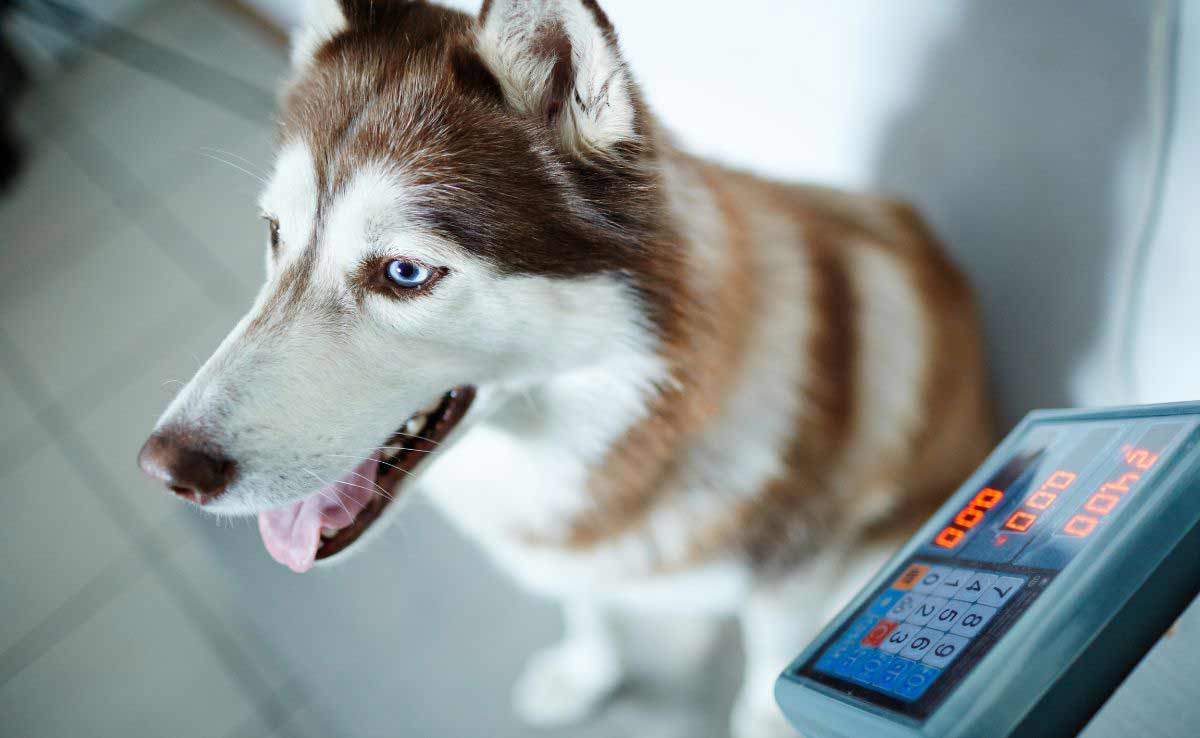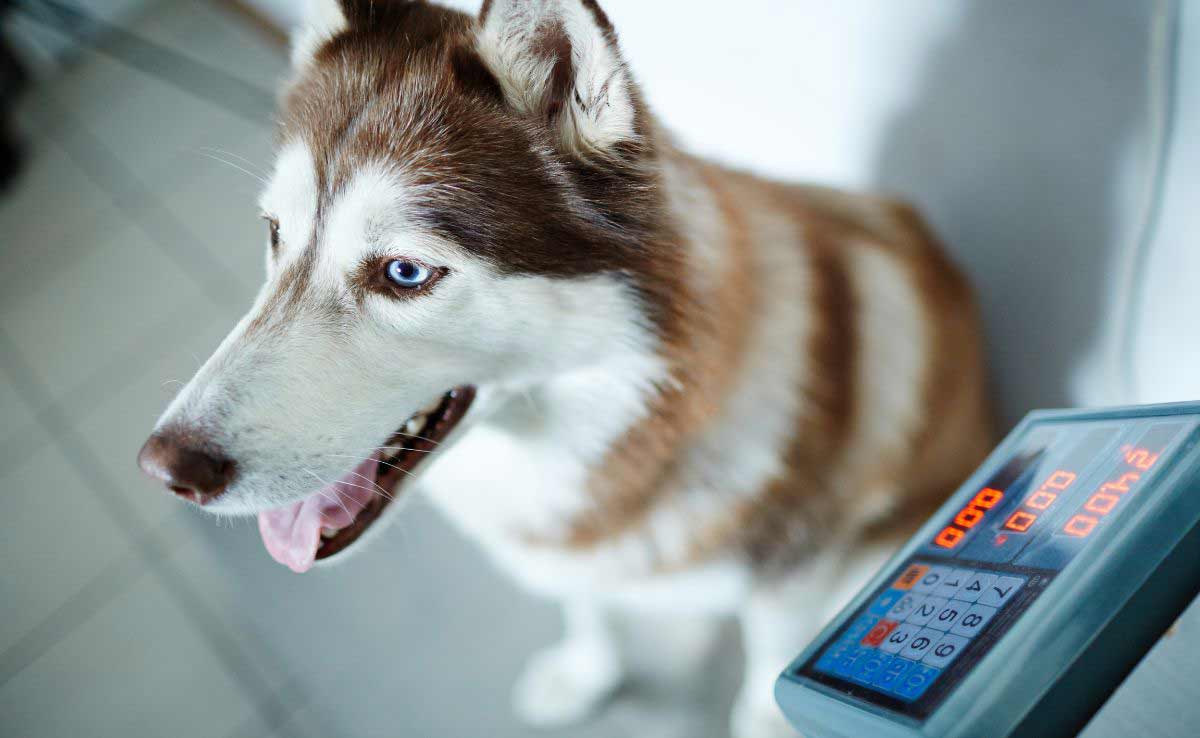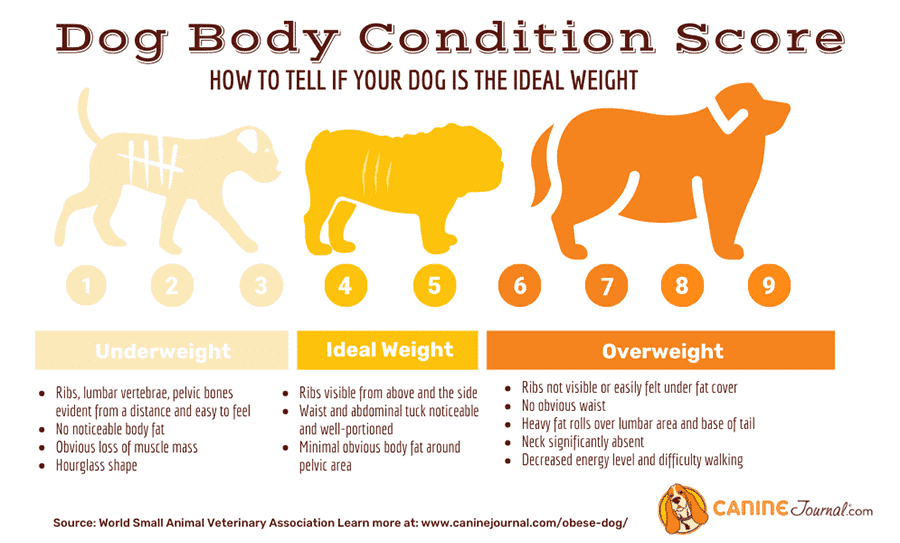
To keep the lights on, we receive affiliate commissions via some of our links. Our review process.

You may not realize how important it is to keep your dog at a healthy weight. Even a few extra pounds, especially in small to medium-sized dogs, can make your pup much more vulnerable to many canine diseases. And underweight dogs may be suffering from health conditions or an insufficient diet.
If you’re concerned that your dog isn’t at a healthy weight, we’ll help you figure out how much your furry friend should weigh, tips on how to help your pup get to a healthy weight, and more.
How Much Should My Dog Weigh?
Contents
Several factors play into a dog’s ideal weight, including body type, size, and gender. Breeds have so many various body types and sizes that it’s difficult to determine an exact ideal weight. And mixed breeds can make it even harder. If you have a purebred, it’s easier to find out what your dog breed’s average weight should be by looking at a weight chart (see below). However, even weight charts have a wide range of average weights.
Use The Body Condition Scoring System (BCS)
That’s why most veterinary clinics use a body condition scoring system (BCS) like the one below to determine if a dog is too thin, at a healthy weight, or overweight. You can evaluate your pup’s BCS by examining his ribs, abdomen, and waistline by sight and touch. If your dog’s score is a 4-5, then weigh him to know his ideal weight. If he falls between a 1-3, he likely needs to gain weight, and a 6-9 means he needs to shed pounds.

How To Check Your Dog’s Body Condition At Home (Video)
Confused about how to determine your dog’s body condition as we explained above? Watch the video below from The Farmer’s Dog, a popular fresh dog food delivery service. It gives you a visual tutorial for several different dog sizes and coat lengths to help you figure out your pup’s body condition. We’ve found it extremely helpful.
How Heavy Should My Dog Be? (By Breed)
Using a BCS system is the best way to tell if your furry friend is at a healthy weight. But it can help to start with a weight chart just to give you a general idea. Typical dog weight charts like the one below are by breed. Keep in mind, that many of these ranges are very wide and don’t account for gender. In general, females should fall to the lower end of the range, while males weigh more.
Dog Weight Chart
This alphabetical chart doesn’t cover all breeds by any means, but it includes many of the popular breeds in the U.S. We’ve also included several popular designer breeds.
| Breed | Average Weight Range |
|---|---|
| Afghan Hounds | 50-60 lbs |
| Airdale Terriers | 40- 65 lbs |
| Akitas | 70-120 lbs |
| Alaskan Malamutes | 75-85 lbs |
| American Staffordshire Terriers | 55-65 lbs |
| Australian Cattle Dogs | 30-35 lbs |
| Australian Shepherds | 40-65 lbs |
| Basenjis | 20-25 lbs |
| Basset Hounds | 40-60 lbs |
| Beagles | 18-30 lbs |
| Bearded Collies | 45-55 lbs |
| Belgian Malinois | 55-75 lbs |
| Bernese Mountain Dogs | 75-110 lbs |
| Bichon Frises | 10-16 lb |
| Black And Tan Coonhounds | 65-110 lbs |
| Bloodhounds | 80-110 lbs |
| Border Collies | 30-45 lbs |
| Border Terriers | 11-15 lbs |
| Boston Terriers | 10-25 lbs |
| Bouvier Des Flanders | 70-110 lbs |
| Boxers | 50-75 lbs |
| Brittany Spaniels | 30-40 lbs |
| Brussels Griffons | 8-10 lbs |
| Bulldogs | 40-50 lbs |
| Bullmastiffs | 100-130 lbs |
| Bull Terriers | 50-70 lbs |
| Bull Terriers (Miniature) | 24-32 lbs |
| Cairn Terriers | 12-16 lbs |
| Cardigan Welsh Corgis | 24-38 lbs |
| Cavalier King Charles Spaniels | 13-18 lbs |
| Chihuahuas | 4-6 lbs |
| Chinese Crested | 8-12 lbs |
| Chinese Shar-Peis | 45-60 lbs |
| Chow Chows | 45-70 lbs |
| Cockapoos | 12-24 lbs |
| Cocker Spaniels | 26-34 lbs |
| Collies | 50-75 lbs |
| Dachshunds (Standard) | 16-32 lbs |
| Dachshunds (Miniature) | 8-10 lbs |
| Dalmatians | 45-75 lbs |
| Doberman Pinschers | 60-95 lbs |
| English Cocker Spaniels | 26-34 lbs |
| English Setters | 45-80 lbs |
| English Springer Spaniels | 40-50 lbs |
| Flat-Coated Retrievers | 60-70 lbs |
| Fox Terriers | 16-18 lbs |
| French Bulldogs | 19-28 lbs |
| German Shepherds | 50-90 lbs |
| German Shorthair Pointers | 45-75 lbs |
| Goldendoodles (Miniature) | 15-30 lbs |
| Goldendoodles (Standard) | 40-50 lbs |
| Golden Retrievers | 55-75 lbs |
| Gordon Setters | 45-80 lbs |
| Great Danes | 110-175 lbs |
| Great Pyrenees | 85-125 lbs |
| Greyhounds | 60-70 lbs |
| Havanese | 7-13 lbs |
| Irish Setters | 60-70 lbs |
| Irish Terriers | 25-27 lbs |
| Irish Wolfhounds | 105-120 lbs |
| Italian Greyhounds | 7-14 lbs |
| Jack Russell Terriers | 14-18 lbs |
| Keeshonds | 35-45 lbs |
| Labrador Retrievers | 55-80 lbs |
| Labradoodles | 50-65 lbs |
| Labradoodles (Miniature) | 15-25 lbs |
| Lhasa Apsos | 12-18 lbs |
| Maltese | 4-6 lbs |
| Mastiffs | 120-200 lbs |
| Miniature Pinschers | 8-10 lbs |
| Newfoundlands | 100-150 lbs |
| Norwegian Elkhounds | 48-55 lbs |
| Norwich Terriers | 10-12 lbs |
| Old English Sheepdogs | 60-100 lbs |
| Papillons | 7-10 lbs |
| Pekingese | 6-10 lbs |
| Pembroke Welsh Corgis | 25-30 lbs |
| Pomeranians | 3-7 lbs |
| Pomsky | 20-30 lbs |
| Poodle (Standard) | 45-70 lbs |
| Poodle (Miniature) | 10-15 lbs |
| Poodle (Toy) | 4-6 lbs |
| Portuguese Water Dogs | 35-60 lbs |
| Pugs | 14-18 lbs |
| Puggles | 15-30 lbs |
| Rat Terriers | 10-25 lbs |
| Rhodesian Ridgebacks | 70-85 lbs |
| Rottweilers | 80-130 lbs |
| St. Bernards | 120-180 lbs |
| Samoyeds | 35-65 lbs |
| Schipperkes | 10-16 lbs |
| Schnauzer (Giant) | 55-85 lbs |
| Schnauzer (Standard) | 30-45 lbs |
| Schnauzer (Miniature) | 12-15 lbs |
| Scottish Terriers | 18-22 lbs |
| Shetland Sheep Dogs | 18-20 lbs |
| Shiba Inus | 17-23 lbs |
| Shih Tzus | 9-16 lbs |
| Siberian Huskies | 35-60 lbs |
| Silky Terriers | 8-10 lbs |
| Staffordshire Bull Terriers | 24-38 lbs |
| Tibetan Terriers | 18-30 lbs |
| Toy Fox Terriers | 4-7 lbs |
| Vizslas | 45-60 lbs |
| Weimaraners | 55-85 lbs |
| Welsh Terriers | 18-20 lbs |
| West Highland Terriers | 15-21 lbs |
| Whippets | 25-40 lbs |
| Wirehaired Pointing Griffons | 40-60 lbs |
| Yorkshire Terriers | 4-7 lbs |
| Yorkshire Terriers (Teacup) | 1-3 lbs |
Why Is Maintaining Your Dog’s Weight So Important?
Many pet parents don’t even realize that their pups are overweight. In a 2021 survey of pet parents by the Association for Pet Obesity Prevention (APOP), only 39% of pet parents said they considered their dog overweight or obese. However, statistics tell a different story.
APOP’s 2018 Veterinary Clinic Prevalence Survey found that an alarming 55.8% of dogs were classified as clinically overweight or obese. And Banfield Pet Hospital revealed in its 2020 VET Report that 51% of the 1.9 million adult dogs seen at Banfield’s clinics nationwide in 2018 were overweight.
If you suspect that your canine companion is heavier than he should be, you should be concerned. What makes a pudgy dog adorably cute can actually be putting him at a much higher risk for serious health consequences, including:
- Orthopedic diseases, like osteoarthritis
- Kidney dysfunction
- Heart problems
- Respiratory disorders
- Cancer
- Skin problems
- Chronic inflammation
- Reduced life expectancy
- Diminished quality of life
What If My Dog Is Underweight?
If you think your canine companion is too thin based on the BCS score above or if you think he isn’t eating enough, consult your veterinarian. A much lower-than-average weight or weight loss requires an expert opinion. Your vet can help determine if it’s due to an underlying health problem or other issues. These could include:
- Underlying health issues: many problems can cause dogs to lose weight, including intestinal parasites, gastrointestinal problems, diabetes, cancer, Addison’s disease, kidney disease, dental disease, stress, and more.
- Insufficient diet: dogs can be underweight if they’re not getting the necessary nutrients and calories they need. Make sure you’re giving your pup high-quality dog food. You may want to consider a fresh dog food company that can customize your dog’s diet if he needs to gain weight. Some even give you pre-portioned meals based on your pup’s caloric needs.
- Your dog is a picky eater: some dogs simply aren’t interested in the food you’ve chosen for them, so try switching your pup’s dog food. See our reviews of the best dog food delivery services for many different all-natural options, including fresh meals, personalized premium kibble, and more.
Tips For Overweight Dogs
Whether your dog is obese or just packing on a few extra pounds, it’s crucial to take action to get your pup to a healthy weight. You can help your dog lose weight by putting him on a diet and getting more exercise. See our reviews of the best dog food for overweight pooches for some premium options you may want to consider. It’s still important to consult your veterinarian to check for any underlying health conditions and help you develop a plan for your pup’s specific weight loss needs.
Tagged With: Obesity